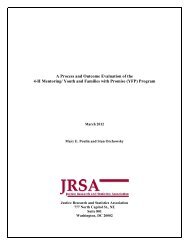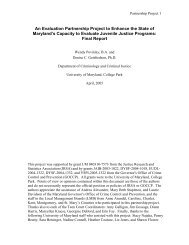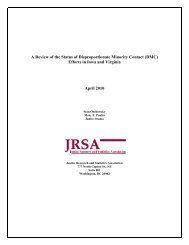Improving the Effectiveness of Juvenile Justice Programs: A New
Improving the Effectiveness of Juvenile Justice Programs: A New
Improving the Effectiveness of Juvenile Justice Programs: A New
Create successful ePaper yourself
Turn your PDF publications into a flip-book with our unique Google optimized e-Paper software.
VII. Integrating Evidence-Based<br />
Practice into <strong>Juvenile</strong> <strong>Justice</strong> Systems<br />
The SPEP provides a critical tool for effective management<br />
<strong>of</strong> juvenile justice systems that has been missing. However<br />
useful it may be for identifying effective programs and<br />
guiding improvement <strong>of</strong> ineffective ones, it is only one<br />
piece <strong>of</strong> <strong>the</strong> juvenile justice puzzle. To make its strongest<br />
contributions to efforts to reduce delinquency, <strong>the</strong> SPEP<br />
must be used as part <strong>of</strong> a comprehensive strategy for<br />
optimizing <strong>the</strong> effectiveness <strong>of</strong> <strong>the</strong> juvenile justice system.<br />
A. A System Reform Framework<br />
The Comprehensive Strategy (CS) for Serious, Violent, and<br />
Chronic <strong>Juvenile</strong> Offenders (Wilson and Howell, 1993,<br />
1994) is a framework for guiding state and local system<br />
reforms to address juvenile delinquency in a cost-effective<br />
manner. The CS is a two-tiered system for responding<br />
proactively to juvenile delinquency (Figure 6). In <strong>the</strong><br />
first tier, delinquency prevention, youth development,<br />
and early intervention programs are relied on to prevent<br />
delinquency and reduce <strong>the</strong> likelihood that at-risk youth<br />
will appear in <strong>the</strong> juvenile justice system. If those efforts<br />
fail, <strong>the</strong>n <strong>the</strong> juvenile justice system, <strong>the</strong> second tier,<br />
must make proactive responses by addressing <strong>the</strong> risk<br />
factors for recidivism and associated treatment needs <strong>of</strong><br />
<strong>the</strong> <strong>of</strong>fenders, particularly those with a high likelihood <strong>of</strong><br />
becoming serious, violent, and chronic <strong>of</strong>fenders. At <strong>the</strong><br />
same time, supervision proportionate to <strong>the</strong> risk to public<br />
safety posed by <strong>the</strong> respective <strong>of</strong>fenders must be applied.<br />
In <strong>the</strong> Comprehensive Strategy framework, <strong>the</strong> supervision<br />
and control component is referred to as sanctions, a term<br />
also used in this fashion in many juvenile justice systems.<br />
Figure 6. The Comprehensive Strategy for Serious, Violent, and Chronic <strong>Juvenile</strong> Offenders<br />
Comprehensive Strategy for<br />
Serious, Violent, and Chronic <strong>Juvenile</strong> Offenders<br />
Problem Behavior > Noncriminal Misbehavior > Delinquency > Serious, Violent, and Chronic Offending<br />
Prevention<br />
Target Population: At-Risk Youth<br />
Intervention & Graduated Sanctions<br />
Target Population: Delinquent Youth<br />
> > > > > ><br />
<strong>Programs</strong> for <strong>Programs</strong> for Youth at Immediate Intermediate Community Training<br />
All Youth Greatest Risk Intervention Sanctions Confinement Schools<br />
Aftercare<br />
Preventing youth from becoming<br />
delinquent by focusing prevention<br />
programs on at-risk youth<br />
<strong>Improving</strong> <strong>the</strong> juvenile justice system response to<br />
delinquent <strong>of</strong>fenders within a continuum <strong>of</strong><br />
treatment options and system <strong>of</strong> graduated sanctions<br />
Sources: Wilson & Howell (1993, 1994); Howell (2003a, 2003b, 2009)<br />
<strong>Improving</strong> <strong>the</strong> <strong>Effectiveness</strong> <strong>of</strong> <strong>Juvenile</strong> <strong>Justice</strong> <strong>Programs</strong>: A <strong>New</strong> Perspective on Evidence-Based Practice<br />
37

















